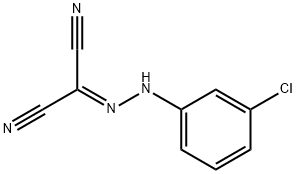555-60-2
 555-60-2 結(jié)構(gòu)式
555-60-2 結(jié)構(gòu)式
基本信息
羰基氰基3-氯苯腙
氰化羰基-3-氯苯腙
氰化羰基間氯苯腙
羰基氰酯-3-氯苯基腙
羰基氰基3-氯苯腙/羰基氰化氯苯腙/CCCP
BUTTPARK 91\04-41
CARBONYL CYANIDE 3-CHLOROPHENYLHYDRAZONE
CARBONYL CYANIDE M-CHLOROPHENYL-HYDRAZONE
CCCP
M-CL-CCP
MESOXALONITRILE (3-CHLOROPHENYL)HYDRAZONE
TIMTEC-BB SBB003506
((3-chlorophenyl)hydrazono)-propanedinitril
[(3-chlorophenyl)hydrazono]-propanedinitril
m-chlorophenylcarbonylcyanidehydrazone
mesoxalonitrile,(m-chlorophenyl)hydrazone
[(3-chlorophenyl)hydrazono]malononitrile
CARBONYL CYANIDE M-CHLOROPHENYL &
Carbonylcyanide3-chlorophenylhydrazone,98%
Carbonyl cyanide 3-chlorophenylhydrazone, 99+%
Carbonylcyanid-m-chlorphenylhydrazon
m-Cl-CCP, Carbonyl cyanide 3-chlorophenylhydrazone, CCCP, Mesoxalonitrile (3-chlorophenyl)hydrazone, Mesoxalonitrile 3-chlorophenylhydrazone
m-Cl-CCP, CCCP, Mesoxalonitrile 3-chlorophenylhydrazone
Carbonyl cyanide m-chlorophenylhydrazone, 99+%
物理化學(xué)性質(zhì)
安全數(shù)據(jù)
| 報價日期 | 產(chǎn)品編號 | 產(chǎn)品名稱 | CAS號 | 包裝 | 價格 |
| 2025/02/08 | HY-100941 | 羰基氰化氯苯腙 CCCP | 555-60-2 | 10 mg | 250元 |
| 2025/02/08 | HY-100941 | 羰基氰化氯苯腙 CCCP | 555-60-2 | 50mg | 500元 |
| 2025/02/08 | HY-100941 | 羰基氰化氯苯腙 CCCP | 555-60-2 | 10mM * 1mLin DMSO | 550元 |
常見問題列表
STING
IFN-β
CCCP inhibits IFN-β production induced by various types of the STING pathway activators. CCCP suppresses the phosphorylation of STING, TBK1, and IRF3 via disrupting the association of STING and TBK1. CCCP inhibits activation of STING and its downstream signaling molecules, TBK1 and IRF3, but not STING translocation to the perinuclear region. CCCP impairs the interaction between STING and TBK1 and concomitantly triggers mitochondria fission. Importantly, the knockout of the crucial mitochondria fission regulator Drp1 restored the STING activity, indicating that CCCP down-modulates the STING pathway through DRP1-mediated mitochondria fragmentation. The protonophore CCCP that disrupts membrane potential suppresses the DMXAA-triggered STING signaling pathway. CCCP drastically suppresses the production of IFN-β in DMXAA-treated RAW264.7 cells and MEFs.
The same dosage of 3?mg/kg.bw each of CCCP and PPEF is used. In both the cases 1?log reduction is observed in the bacterial load. However, when 3?mg/kg.bw of PPEF is used in combination with 3?mg/kg.bw of CCCP, 6 log 10 reduction is observed in the bacterial count. The developed model validates the enhanced antibacterial activity of combination therapy. 99m Tc-MIBI signals in the hearts of SD rats administered CCCP (4 mg/kg intraperitoneally) or vehicle is also measured. 99m Tc-MIBI signals decrease in rat hearts administered CCCP, and the ATP content, as measured by 31 P magnetic resonance spectroscopy, decreased simultaneously. To investigate whether CCCP decreased the 99m Tc-MIBI signals in rats, we analyzed the radioisotope activity of excised heart tissue from rats administered CCCP. At 180 min after 99m Tc-MIBI injection, the 99m Tc-MIBI signals from the hearts in the CCCP group are significantly lower than those in the vehicle group.
